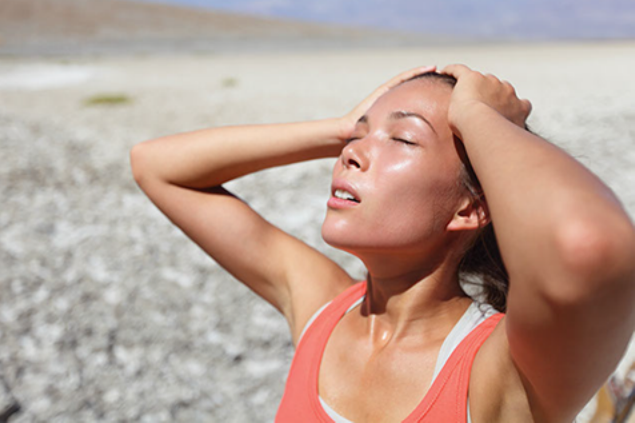SYMPTOM CHECKER
CONDITIONS
Male
Female
Child
Arm, Hand & Shoulder Concerns
Legs & Feet Concerns
Dental & Mouth Concerns
Ear & Nose
Eye Conditions
Head Conditions
Arm, Hand & Shoulder Concerns
Legs & Feet Concerns
Front
Back
Arm, Hand & Shoulder Concerns
Dental & Mouth Concerns
Ear & Nose
Eye Conditions
Head Conditions
Arm, Hand & Shoulder Concerns
Dental & Mouth Concerns
Ear & Nose
Eye Conditions
Head Conditions
Front
Back
Arm, Hand & Shoulder Concerns
Neck Links
Head & Neck Concerns
Arm, Hand & Shoulder Concerns
Neck Links
Head & Neck Concerns
Front
Back
Online Clinic
Wise Healthcare
Heat & humidity:
A dangerous combination
Print on Demand
Heat and humidity can trigger three major illnesses, according to Dr. Eric Kirkendall, of Cincinnati Children’s Hospital Medical Center:
Heat stroke symptoms include hot flushed skin, high fevers (over 104ºF), altered mental states such as confusion, and can be accompanied by seizures. Heat stroke is a life-threatening emergency and needs to be treated promptly.
Heat stroke is a 911 emergency. Cool the person off as quickly as possible while waiting for medical services to arrive. Move the person to a cool shady place or an air-conditioned room; sponge the entire body surface with cool water (as tolerated without causing shivering); and fan the person to increase heat loss from evaporation. Keep the feet elevated to counteract shock. If the person is awake, give him or her as much cold water to drink as he or she can tolerate. Fever medicines are of no value for heat stroke.
Heat exhaustion symptoms include pale skin, profuse sweating, nausea, vomiting, muscle cramps, or weakness. It is less severe than heat stroke but is still dangerous and may require medical attention.
For heat exhaustion, put the person in a cool place indoors or in the shade. Have him or her lie down with the feet elevated. Undress the person (except for underwear) so the body surface can give off heat. Sponge the entire body surface continuously with cool water without causing shivering. Fan the person to increase heat loss from evaporation. Give as much cool, not cold water or sport drinks as the person tolerates until he or she feels better. If symptoms do not improve or the person gets light-headed or faints, get medical care right away.
Heat cramps are most common in the abdomen and legs, especially the calf or thigh muscles. Tightness or hand spasms can also occur, but fever is not a symptom.
For heat cramps, monitor physical activity and make sure children don’t overly exert themselves. Adults can self-monitor. Make sure children drink plenty of water often. Encourage frequent breaks from physical activity to cool down and gently stretch muscles.
This website is not meant to substitute for expert medical advice or treatment. Follow your doctor’s or health care provider’s advice if it differs from what is given in this guide.
The American Institute for Preventive Medicine (AIPM) is not responsible for the availability or content of external sites, nor does AIPM endorse them. Also, it is the responsibility of the user to examine the copyright and licensing restrictions of external pages and to secure all necessary permission.
The content on this website is proprietary. You may not modify, copy, reproduce, republish, upload, post, transmit, or distribute, in any manner, the material on the website without the written permission of AIPM.
2021 © American Institute for Preventive Medicine - All Rights Reserved. Disclaimer | www.HealthyLife.com
















































